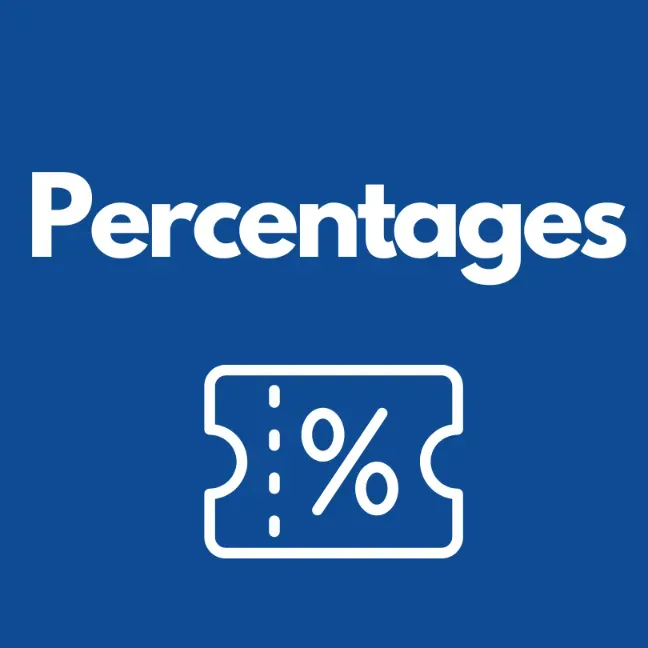Percentage Increase Calculator
Enter two values to calculate the % increase
Related Percentage Calculators
See all maths calculators
Understanding Percentage Increase
Percentage increase is a fundamental mathematical concept used to quantify the relative growth or rise in value between two numbers. Whether you're analyzing sales figures, tracking population growth, or comparing economic indicators, understanding how to calculate and interpret percentage increases is essential. This guide will explore the ins and outs of percentage increase, providing you with the knowledge and tools to confidently work with this important metric.
Introduction
In our daily lives and professional environments, we frequently encounter situations where we need to compare two values and express their difference as a percentage. When the newer or final value is larger than the original or initial value, we refer to this change as a percentage increase. This concept is widely used in finance, economics, science, and many other fields to provide context and meaning to numerical changes.
What is Percentage Increase?
Percentage increase represents the relative growth in value from an original amount to a new, higher amount, expressed as a percentage of the original value. It answers the question, "By what percentage has the value grown?"
For example, if a product's price rises from $100 to $120, we would say there has been a 20% increase in price. This percentage gives us a standardized way to compare changes across different scales and contexts.
How to Calculate Percentage Increase
Calculating percentage increase involves a simple formula:
Percentage Increase = [(New Value - Original Value) / Original Value] × 100
Let's break this down into steps:
- Subtract the original value from the new value to find the absolute increase.
- Divide this difference by the original value.
- Multiply the result by 100 to convert it to a percentage.
Example Calculation
Suppose a company's annual revenue grows from $1 million to $1.5 million.
- Absolute increase: $1.5 million - $1 million = $0.5 million
- Relative increase: $0.5 million / $1 million = 0.5
- Percentage increase: 0.5 × 100 = 50%
Therefore, the company's revenue has increased by 50%.
Common Applications of Percentage Increase
Understanding percentage increase is valuable in various real-world scenarios:
1. Finance and Economics
- Investment Returns: Investors use percentage increase to evaluate the performance of stocks, bonds, and other assets.
- Economic Growth: Economists measure GDP growth and inflation rates using percentage increases.
2. Business and Sales
- Revenue Growth: Companies track percentage increases in sales to measure business performance.
- Market Share: Businesses analyze percentage increases in market share to assess competitive positioning.
3. Population Studies
- Demographic Changes: Sociologists and urban planners use percentage increases to analyze population growth in cities or countries.
- Biological Research: Scientists measure percentage increases in cell populations or organism growth rates.
4. Technology and Performance
- Processing Speed: Computer engineers quantify improvements in processor performance using percentage increases.
- Energy Efficiency: Manufacturers highlight percentage increases in energy efficiency for appliances and vehicles.
Common Mistakes and How to Avoid Them
When working with percentage increases, it's easy to make errors that can lead to misinterpretation of data. Here are some common pitfalls and how to avoid them:
- Confusing Percentage Points with Percentages: An increase from 40% to 50% is a 10 percentage point increase, but a 25% percentage increase. Be clear about which you're referring to.
- Using the Wrong Base Value: Always use the original value as the base for calculating percentage increase. Using the new value will give an incorrect result.
- Neglecting to Convert to Percentage: Remember to multiply your final calculation by 100 to express the result as a percentage.
- Misinterpreting Negative Percentages: If your calculation yields a negative percentage, it actually indicates a decrease, not an increase.
Advanced Concepts: Compound Percentage Increase
In some scenarios, you may encounter compound percentage increases, where multiple growth rates are applied sequentially. For example, a 10% increase followed by another 10% increase does not result in a 20% total increase.
To calculate compound percentage increases:
- Convert each percentage increase to a decimal (e.g., 10% becomes 0.1)
- Add each decimal to 1 (e.g., 1 + 0.1 = 1.1)
- Multiply these values together
- Subtract 1 from the result and multiply by 100 to get the total percentage increase
For two 10% increases: (1 + 0.1) × (1 + 0.1) = 1.21
Total increase: (1.21 - 1) × 100 = 21%
This concept is particularly important in financial calculations, such as determining compound interest or projecting long-term growth rates.
Conclusion
Percentage increase is a powerful tool for quantifying and comparing growth across various domains. By mastering the calculation and interpretation of percentage increases, you'll be better equipped to analyze trends, make informed decisions, and communicate changes effectively. Whether you're a student, professional, or simply someone interested in understanding the world through numbers, the ability to work with percentage increases is an invaluable skill.
Key Takeaways
- Percentage increase measures the relative growth from an original value to a new, higher value.
- The formula for percentage increase is: [(New Value - Original Value) / Original Value] × 100
- Percentage increase is widely used in finance, business, population studies, and technology assessment.
- Common mistakes include confusing percentage points with percentages and using the wrong base value.
- Compound percentage increases require special calculation methods to determine the total increase accurately.
By understanding and applying the concepts of percentage increase, you'll be better equipped to interpret data, make comparisons, and draw meaningful conclusions in various personal and professional contexts.

